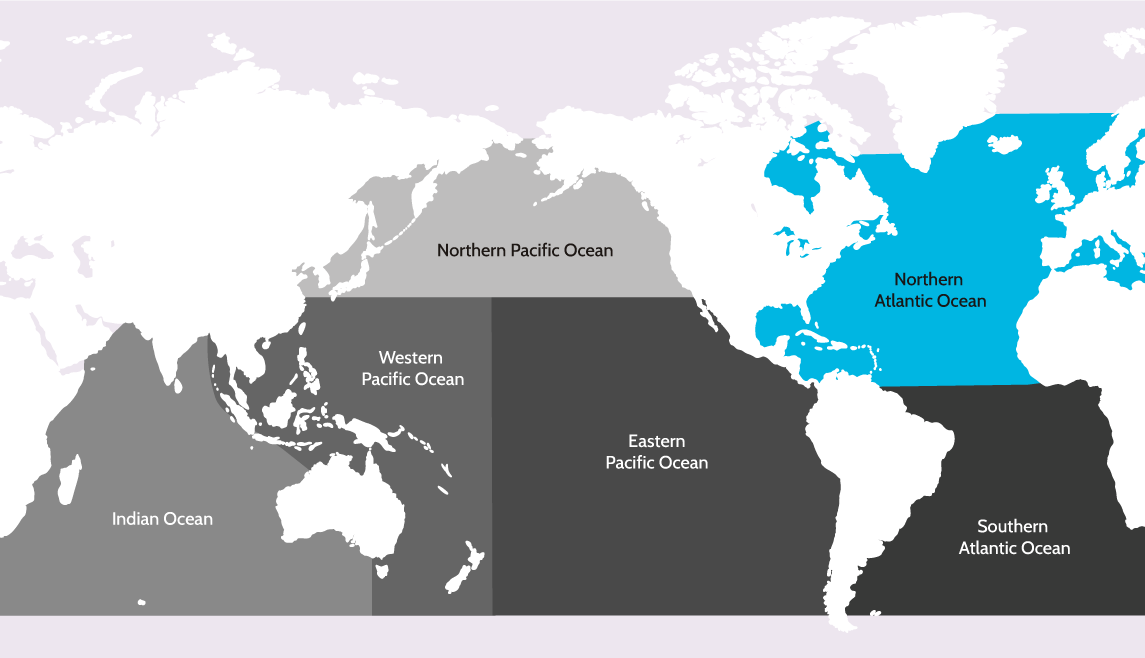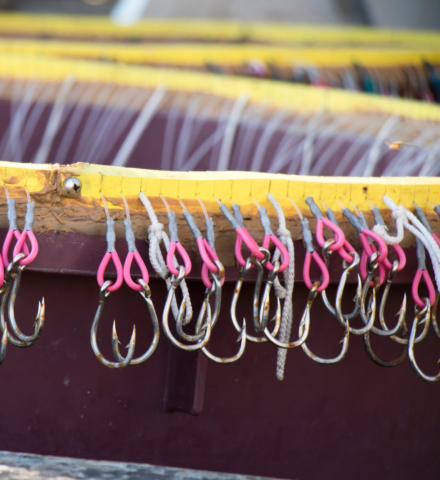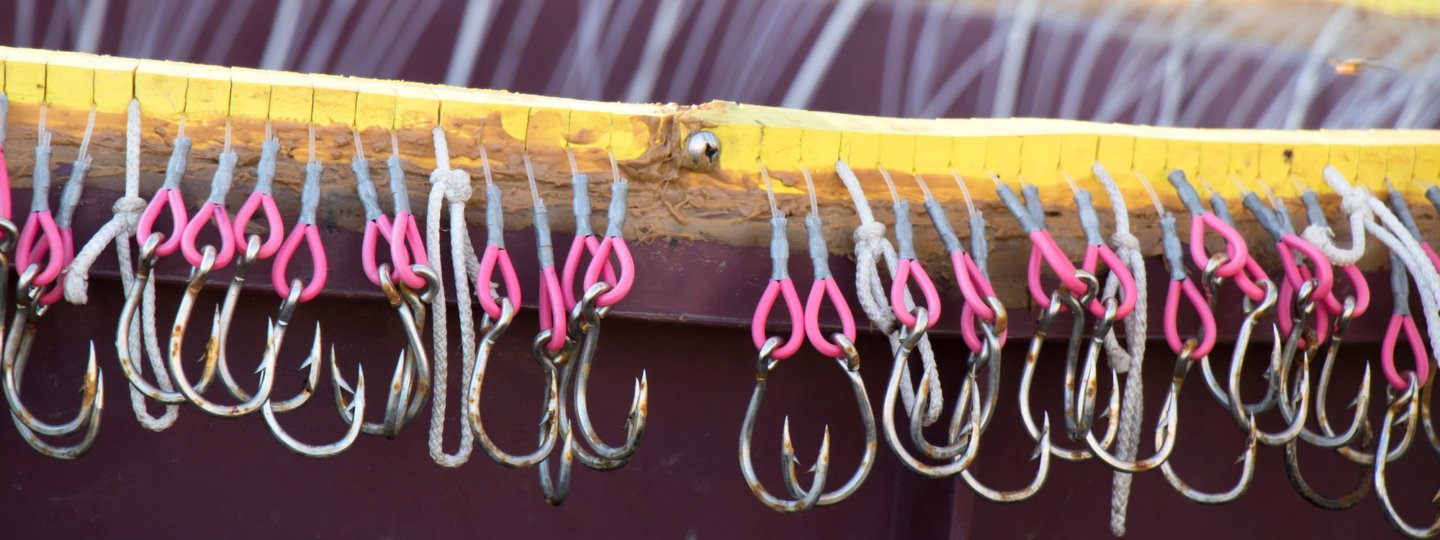Longline
Northern Atlantic Ocean
Longlines consist of hundreds to thousands of baited hooks that branch off a mainline that can be miles long. Depending on target species, longlines are deployed either in the open ocean (pelagic fisheries) or along the ocean bottom (benthic fisheries).


Target Species
Groundfish
Swordfish
Tuna
Bycatch Species
Sea Turtles
Seabirds
Sharks and Rays
Solutions
View allFunding Opportunities
View allDescription
The Namibian Demersal Longline fishery is comprised of 19 vessels operating from Walvis-Bay and Lüderitz. They target Cape hakes using a double line “Spanish-system” with alternate dropper lines and weights. Each set lasts 2–3 hours and deploy an average of 16,500 baited hooks. This gear presents an elevated risk to seabirds because the addition of floats results in hooks being available to seabirds for longer periods of time. 20,000 seabirds were being killed annually in this fishery, mainly White-chinned petrels, but also of Endangered Atlantic yellow-nosed albatrosses. The introduction of Bird-Scaring Lines (BSL) regulation however demonstrated that bycatch can be reduced by >98% if BSLs are properly deployed. While significant efforts have been made by government agencies in Namibia, compliance monitoring relying on human observers is limited and costly. Cameras to monitor the usage of BSL is a cost-effective solution to reach 100% coverage, ensuring highest compliance with regulation.
In this collaboration with the Albatross Task Force, cameras will be deployed on two vessels to monitor the deployment of BSL during fishing operations. On each boat at least one high-definition camera will be deployed and set to capture a picture every 15 min to check BSL compliance according to regulation in Namibia. The use of cameras to capture single shots rather than videos answers privacy concerns onboard and limits the cost to store and manually check large amount of data. For each longline setting, 8- 12 pictures will be recorded per camera. This method has been successfully trialled in an Argentinian Trawl fishery, showing that the adoption of cameras has increased BSL usage from 30% to 82% in less than two years.
This project will last for a year and will be used to develop with an action plan to equip the entire fleet (19 vessels) with this compliance system.
Beneficiary: Namibia Nature Foundation
- EM Implementation for Two Vessels $29,084 USD
Description
The Vietnam tuna handline/longline fishery primarily targets yellowfin tuna but also includes commercial catch of bigeye tuna, swordfish, blue marlin, striped marlin and wahoo from the western and central Pacific Ocean. During the FIP pre-assessment, they also documented bycatch interactions with sharks, rays, and sea turtles that get caught on the baited hooks.
Working with the Vietnamese fisheries association VINATUNA and FIP manager Sea Delight, this funding opportunity will reduce bycatch impacts on sharks, rays and sea turtles utilizing a comprehensive approach. This project will support best handling and release training workshops for 240 vessel captains and bycatch monitoring workshops for 40 port observers, expansion of the newly initiated at sea monitoring devices (COPPA), distribution of 1-year of circle hooks for 250 vessels (recognized best practice), and the printing and posting of Western Pacific Ocean Key Species and Discard Release posters on vessels and at major landing ports.
Trainings for both vessel captains and portside observers, informational posters, and expansion of the COPPA program will have long-term impacts on bycatch reduction in the fishery while circle hooks will immediately reduce bycatch rates for sharks, rays, and sea turtles. Additional support to provide a second year of circle hooks is possible and recommended.
Click "I'm Interested" to contact the Bycatch Solutions Hub for more details.
Beneficiary: VINATUNA
- Comprehensive Bycatch Reduction Project $51,127 USD
- Additional Year of Circle Hooks $12,570 USD
Description
The Swordfish Deep Buoy Set Gear (DBSG) experimental fishery is a low-bycatch alternative to traditional commercial gear targeting swordfish, pelagic longlines and drifting gillnets. DSBG reduces bycatch by setting beneath the thermocline, where non-targeted species are uncommon, and promoting the removal of high-risk traditional longline and gillnet fisheries.
A major challenge in the DBSG fishery is the ability to locate the gear in rough or foggy conditions, and at night. By using smart buoys, fishers will always know exactly where their lines are and can quickly recover them. This not only prevents any from being lost, but drastically decreases the amount of time spent looking for gear, increasing catch rates. In addition, they do not have to keep gear in sight which improves the fishing experience by decreasing their exposure to dangerous conditions on deck. Last swordfish season, 2022-23, three vessels fished successfully using smart buoys and more vessels have requested interest in adopting the technology.
This funding opportunity fully outfits two swordfish DSBG vessels registered to an Experimental Fishing Permit off the coast of southern California with Blue Ocean Gear Farallon Smart Buoys. Each vessel will receive ten Smart Buoys and 1 Wireless Charger, a software plan, initial training in their use, and technical support throughout the fishing season, September 2023 to March 2024. Updates will be provided after implementation, after the season, and the beginning of the next season in the fall of 2024.
Click "I'm Interested" to contact the Bycatch Solutions Hub for more details.
Beneficiary: Blue Ocean Gear
- Fully Outfit 2 DSBG Vessels $27,750 USD

